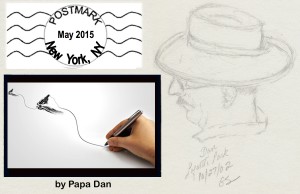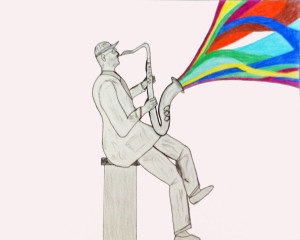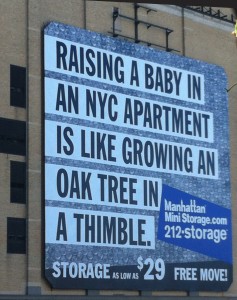Archive for Art by PapaDan
The Saxophone Guy: Where Does It Come From?
 We hear evidence of him long before we see him. The long meandering notes from his saxophone alternately sprayed . . . poured . . . erupted . . . oozed . . . out of his horn in a dazzling array of colors that originated in his mind, from under his hat — a gift to anyone who happened by to hear it. But, where does it all come from?
We hear evidence of him long before we see him. The long meandering notes from his saxophone alternately sprayed . . . poured . . . erupted . . . oozed . . . out of his horn in a dazzling array of colors that originated in his mind, from under his hat — a gift to anyone who happened by to hear it. But, where does it all come from?
= = = = = = =
So, Gretta had been painting with watercolors for years and I wanted to try. Looks interesting. Gotta start with a drawing . . . saw a picture of a saxophone guy somewhere. . . figured maybe I could draw it . . . maybe. Grabbed a big piece of paper and a pencil.
Now what?
First observation: where do I start? In writing, one might just begin at the beginning — certainly at the top of the page. But this is different. Where on the blank piece of paper do I place the pencil first? Should I start with what he’s sitting on? Should I draw the guy first? And the bigger question: what do you do when you have no skill, no training, no experience?
OK, right, start with the hat.
 Second observation: the eraser turns out to be more important than I realized, just as useful a tool as the pencil — in my case, perhaps more useful.
Second observation: the eraser turns out to be more important than I realized, just as useful a tool as the pencil — in my case, perhaps more useful.
The shape of the jacket seems to define the guy. Pants. Spend some time on the head and face. What is he thinking? (And, if I knew, how would I show that? It’s just an outline really, after all that erasing.) Are the proportions right? I suppose. So, his clothing will have shadows, wrinkles, folds, contours, bits of shading. And shoes. What kind of shoes? Then, of course, the instrument itself has lots of curves and small features (a trumpet would have been easier). Maybe it doesn’t need so much detail.
Time to stop and take a hard look. Have I captured, or hinted at, his concentration; have I implied that he was lost in his music, enthralled by it, maybe with his eyes closed. Fingers! Have you ever tried to draw fingers? Fingers are harder than they seem. Way harder!
Take another look. OK, I’ve got a guy and a saxophone. Not too bad, I mean, you know, mostly.
Third observation: So, what’s happening in my picture? It’s just shades of gray; but now for the hard part. How do I represent the music? What does music look like? Does it change the scene? Is there a relationship between the surroundings, the way the guy looks, and the kind of music? Does the music just happen? Where does it come from?
As the artist (well, the guy with the pencil), it might be worth asking where does the drawing come from? Why am I drawing this guy? Is there something about the saxophone that appeals to me? What is it about him that got my attention? Where is he sitting? Is he on a stage? In a coffee shop? On a park bench? On a stoop in his neighborhood? Are people listening? If they are, how does it affect them? Have they chosen to sit and listen to his music or has he interrupted the quiet of their public space? I guess I’ll think about the foreground and background later.
Time for some speculation. Maybe it didn’t used to be this quiet when it was an ‘actual working-class neighborhood’ a couple of years ago, before the bottom fell out of everything. There may have been dozens of people going to and from work at several small businesses around the corner and a block over; and there haven’t been many cars on Hauser Street since the drugstore moved uptown, the grocery went out of business, and the upholstery shop closed. Not many of the garages on this block have cars in them these days; so there isn’t much traffic to interfere with the music.
Maybe he selected this spot a few months ago — as an exercise in calmness — because the configuration of these two-story wood-frame houses created a natural sound stage here in the middle of the block where the notes bounced back to him, amplifying individual notes into a more full, more dignified sound. When he closed his eyes, could he imagine a concert hall full of silent listeners enjoying the subtle combination of minor keys and alternating rhythms he was so proud of. It had been awhile since anyone actually listened to his music; so his imagination provided his only appreciative audience.
Actually, when he first selected this spot, I suppose the only audience responses he got were the “can’t you take that somewhere else?” and “Oh, no, not again” blurts from the near neighbors. But, even that reaction seems to have died away as locals stopped expecting to have any control, or even influence over their surroundings.
 His own third-floor walk-up at the corner of 14th is comfortable, if small, with a street-side window that looks out on a billboard advertising a mini-storage company. “Raising a baby in an NYC apartment is like growing an oak tree in a thimble,” it said. He still thinks of the sign as an expression of optimism; but he doesn’t notice it much lately. Three days a week he takes the bus to his job at the Laughing Cavalier where he waits tables and washes dishes. It was a bit of a shock when his hours were reduced from full time, but he learned to make do without a car; and he was amazed how much it cut his expenses. It turned out to be a decent trade-off, for now, at least.
His own third-floor walk-up at the corner of 14th is comfortable, if small, with a street-side window that looks out on a billboard advertising a mini-storage company. “Raising a baby in an NYC apartment is like growing an oak tree in a thimble,” it said. He still thinks of the sign as an expression of optimism; but he doesn’t notice it much lately. Three days a week he takes the bus to his job at the Laughing Cavalier where he waits tables and washes dishes. It was a bit of a shock when his hours were reduced from full time, but he learned to make do without a car; and he was amazed how much it cut his expenses. It turned out to be a decent trade-off, for now, at least.
Two days a week he looks at the job ads on the bulletin board at the laundromat; but that doesn’t take more than a few minutes. The newspaper says that an ‘economic recovery’ has started to show itself across the country; but he’s not sure what that is supposed to look like in his neighborhood. He typically gets to his ‘spot’ by about ten and the music begins. He plays mostly songs made-up on the spot — not so much ‘songs,’ really, as attempts to reconstruct the sounds he remembered from the days when his Dad played ‘smooth jazz’ from Pandora back when he had an iPhone. But the days of free Internet ‘Aps’ are gone. Advertising revenues that used to pay for the ‘free Internet’ are not as lucrative today as they were back in the 2020s, now that retail sales are so weak. The old notion that name recognition from website advertising contributed significantly to consumer purchasing has been all but abandoned by this time. While the commercial sector was looking for another business model to reinvigorate the value of the Internet, the consumer economy was in temporary free fall. Surely it was ‘temporary.’ Optimists believed that another innovative business model was ‘just around the corner’ and would come to the rescue as it had done back in the 20th century and early in this one. But, in the mean time, most of what used to be the middle class was just trying to survive in this new world of lowered expectations.
Our saxophone guy, while not so much an optimist, was trying to survive with his part-time job and afternoons with his music. He didn’t think much these days that he was waiting for better times to start; his is a simpler goal – just trying to find enjoyment in hearing his own music bounce back to him on this quiet street. It wasn’t so bad as long as he didn’t think much beyond the present moment. When he was a kid, he had been taught that “living in the present” was an important ‘spiritual’ value to pursue. But now, in his late twenties, it was pretty much the only practical choice for the moment.
And me, the guy with the pencil? What have I learned? I learned that our Saxophone Guy makes the music look easy even if it isn’t, and for me, drawing the picture is harder than it looks.
Download a PDF of this post: Saxophone_Guy_ConVivio_May2015